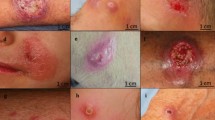Summary
This is a case report of kala-azar with cutaneous leishmaniasis. Upon admission, the patient had fever, hepatosplenomegaly and an ulcer on her cheek. The patient responded to Pentostam. Isoenzyme studies of parasite isolates from the the bone marrow and from the cutaneous lesion revealed that these were L. donovani and L. major, respectively. This is the first report in Iraq of a proven concomitant infection with two species of leishmania parasites.
Zusammenfassung
Wir präsentieren eine Fallstudie von Kala-Azar mit gleichzeitiger kutaner Leishmaniose, Die Patientin hatte Fieber, Hepatosplenomegalie und einen Ulcus an der einen Wange. Sie sprach auf Pentostam an. Die Analyse der Isoenzym-Profile der Parasiten aus einer Knochenmarks-Punktion sowie aus dem Ulcus wiesen nach, dass es sich dabei um L. donovani und um L. major handelte. Diese Studie ist die erste Beschreibung einer simultanen Infektion mit L. donovani und mit L. major im Irak.
Résumé
Notre étude rapporte un cas de Kala-Azar accompagné d'une leishmaniose cutanée. La patiente avait la fièvre, une hépatosplénomégalie et un ulcère à une de ses joux. L'infection répondait bien à la Pentostame. L'analyse des isoenzymes montrait que les parasites isolés de la moile osseuse représentaient L. donovani, pendant que ceux de la lésion cutanée représentaient L. major. Notre rapport constitue la première documentation d'un cas d'une infection simultanée par L. donovani et L. major en Iraq.
Similar content being viewed by others
References
Al-Hussayni NK, Rassam MB, Jawdat SZ, Wahid FN. Numerical taxonomy of some Old World Leishmania species. Trans R Soc Trop Med Hyg 1987;81:581–586.
Al-Jeboori TI, Evans DA. Leismania spp. in Iraq. Electrophoretic isoenzyme patterns. I. Visceral leishmaniasis. Trans R Soc Trop Med Hyg 1980a;72:169–177.
Al-Jeboori TI, Evans DA. Leishmania spp in Iraq. Electrophoretic isoenzyme patterns. II. Cutaneous leishmaniasis. Trans R Soc Trop Med Hyg 1980b;74:178–184.
Rassam MB, Al-Mudaffar SA, Chance ML. Isoenzyme characterization of Leishmania species from Iraq. Ann Trop Med Parasit 1979;73:527–534.
Sukkar FJ. Kala Azar in Iraq 1975. Bull End Dis 1979;XIX:29–38.
Rassam MB, Jawdat SZ, Al-Hussayni NK, Rifaat LK, Sukkar FJ. Biochemical study on Leishmania with some epidemiological application on leishmaniasis in Iraq. J Biol Sci Baghdad 1985;16:83–103.
Morsy TA, Sarwat MA, Al-Shaiby AZ, Fawzy AF, Arafa MA. Isoenzyme characterization of Leishmania isolates from patients in El-Nour Specialized Hospital. J Egypt Soc Parasitol 1993;23:871–876.
Killick-Kendrick R, Peters W. Leishmaniasis in Arabia. An annotated bibliography. Am J Trop Med Hyg 1991;44:1–64.
Dereure J, Rioux JA, Khiami A, Pratlong F, Perieries J, Martini A. Ecoépidemiologie des leishmanioses en Syrie. 2. Présence, chez le chien, de Leishmania infantum et Leishmania tropica. Ann Parasitol Hum Comp 1991;66:252–255.
Peters W. Heterogeneity of cutaneous leishmaniasis with emphasis on the Old World. Schweiz Med Wochenschr 1993;123:1237–1249.
Alvar J, Ballesteros JA, Soler R, Benito A, Vaneys GJJM, Schoone GJ, Cabrer B. Mucocutaneous leishmaniasis due to Leishmania infantum — biochemical characterization. Am J Trop Med Hyg 1990;43:614–618.
Rioux JA, Lanotte G. Leishmania infantum as a cause of cutaneous leishmaniasis. Trans R Soc Trop Med Hyg 1990;84:898.
Mebrahtu Y, Lawyer P, Githure J, Were JB, Muigal R, Hendricks L, Leeuwenburg J, Koech D, Roberts C. Visceral leishmaniasis unresponsive to pentostam caused by Leishmania tropica in Kenya. Am J Trop Med Hyg 1989;41:289–294.
Yebra M, Segovia J, Manzano L, Vargas JA, Bernaldo de Quiros L, Alvar J. Disseminated-to-skin Kala-azar and the acquired immunodeficiency syndrome. Ann Intern Med 1988;108:490–491.
Coutinho SG, Nunes MP, Marzochi MC, Tramontano N. A survey of American cutaneous and visceral leishmaniasis among 1342 dogs from areas in Rio de Janeiro where the human diseases occur. Mem Inst Oswaldo Cruz 1985;80:17–22.
Ashford RW, Smith DH. Leishmaniasis in the Sudan, Ethiopia and Kenya. In: Chang K. P., Bray R. S. eds. Human Parasitic Diseases, vol 1. Amsterdam: Elsevier, 1985:337–391.
Evans DA, Lanham SM, Baldwin CI, Peters W. The isolation and isoenzyme characterization of Leishmania brazilienses subsp. from patients with cutaneous leishmaniasis acquired in Belize. Trans R Soc Trop Med Hyg 1984;78:35–42.
Urjel R, Recacoechea M, LaFuente C, Orellana H. A simple method for the collection of material from cutaneous and mucocutaneous leishmaniasis lesions. Trans R Soc Trop Med 1983;77:882–883.
Jawad J, Khairy N, Sukkar F. Evaluation of an indirect immunofluorescence antibody test for the diagnosis of Kala Azar in Iraq. J Fac Med Baghdad 1981;23:189–196.
Al-Awkati N, Khairy N. Post-Kala Azar dermal leishmanoid in an Iraqi child. J Fac Med Baghdad 1980;22:305–309.
Jawdat SZ, Ali NA, Rifaat LK, Rutha KY. The incidence of Kala-Azar in an endemic focus in central Iraq. J Biol Sci Baghdad 1983;14:81–87.
Sukkar F. Some statistical data on Kala Azar in Iraq. Bull End Dis 1976;XVII:75–79.
Author information
Authors and Affiliations
Rights and permissions
About this article
Cite this article
Al-Diwany, L.J., Al-Awkati, N.A., Atia, M. et al. Concomitant natural infection with L. donovani and L. major: A case report from Iraq. Soz Präventivmed 40, 234–238 (1995). https://doi.org/10.1007/BF01354478
Issue Date:
DOI: https://doi.org/10.1007/BF01354478




